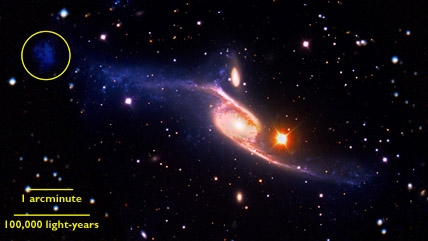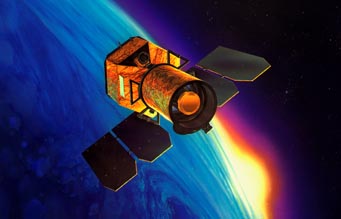Observations with NASA's Galaxy Evolution Explorer spacecraft finds that the spiral galaxy NGC 6872, in Pavo, is an estimated 522,000 light-years across — more than five times the size of our Milky Way galaxy.
When it comes to the "800-pound gorillas" of the cosmos, spiral and elliptical galaxies are right up there. For example, our own Local Group of galaxies hosts three examples of big, beefy spirals: the Triangulum Galaxy (M33), about 50,000 light-years across; the Milky Way Galaxy (100,000 light-years), and the iconic Andromeda Galaxy (M31), now known to span some 220,000 light-years.

This composite of visible, infrared, and ulatraviolet images shows the giant barred spiral galaxy NGC 6872 and the much smaller lenticular galaxy IC 2970 (just above center). The two collided some 130 million years ago, which extended the spiral's arms and created a previously unsuspected dwarf galaxy (circled) where many hot young stars are forming. Click here for a larger version.
NASA / GSFC / ESO / JPL-Caltech / DSS
Yet these giants are no match for the new record-holder among spirals: NGC 6872.
Astronomers have long realized that this spiral is very big, appearing 6 arcminutes across in the southern constellation Pavo despite being some 212 million light-years away. But a team of observers has found that NGC 6872 has extended arms that make it even larger than imagined — five times the size of the Milky Way.
Rafael Eufrasio (NASA/Goddard Space Flight Center) and four colleagues came to this conclusion after combining archival data from several sources: visible images from ESO's Very Large Telescope, infrared views from Two Micron All Sky Survey (2MASS) and the Spitzer Space Observatory, and ultraviolet observations from NASA's Galaxy Evolution Explorer.
In one sense, NGC 6872 has an unfair advantage in the size sweepstakes. About 130 million years ago it collided with IC 4970, a much smaller lenticular galaxy. The ongoing gravitational tug of war between them has created tidally distortions throughout the system, particularly a disturbed region in NGC 6872's northeastern arm. This extension, more than 100,000 light-years long and tipped by a dwarf galaxy, is crowded with hot young stars shining unseen in visible light but revealed in GALEX's ultraviolet images.
Notably, despite its size, NGC 6872 likely contains little free hydrogen with which to make new stars on its own. Had it not collided with IC 4970, today it would have been considerably smaller and might be exhibiting little or no evidence of ongoing star formation at all.

The Galaxy Evolution Explorer (GALEX) launched successfuly aboard a Pegasus rocket on April 28, 2003.
Karl Forster / Caltech
Eufrasio presented his team's work at last week's meeting of the American Astronomical Society. You can also read about it in this NASA press release.
By the way, GALEX is basically "on loan" to astronomers at the California Institute of Technology. In a first-of-its-kind arrangement, last year NASA turned the spacecraft's operation — and the funding to do so — over to this private institution.
 2
2
Comments
J Hanford
January 12, 2013 at 6:54 pm
Thanks Kelly for posting a link to the Eufrasio paper presented at the 2013 AAS meeting. Some NASA sites had links to a 2007 paper on NGC 6872 that had no mention of any GALEX data or the newly discovered TDG discussed in Eufrasio et al. Still waiting for an arXiv posting of this paper.
You must be logged in to post a comment.
Alison
January 26, 2013 at 10:36 pm
Hmmm... this is the 2nd time I have discovered that pictures in an article are not visible unless one is signed in to S&T. Reading on a link from the e-mail doesn't suffice. Is this a glitch, or some new system?
You must be logged in to post a comment.
You must be logged in to post a comment.